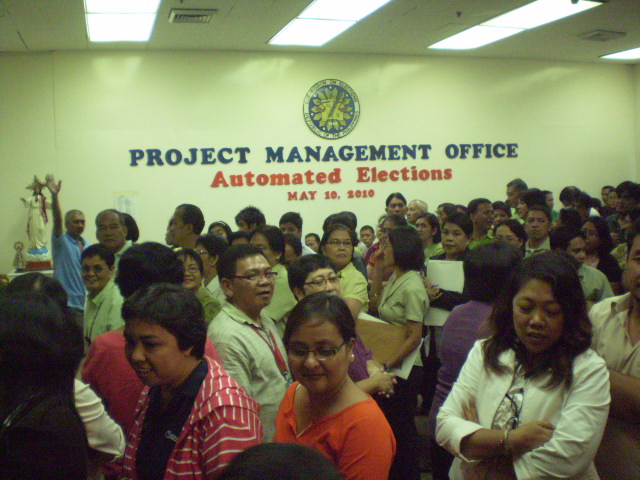The Commission on Elections (Comelec) on Thursday said low voter awareness of the automated elections is expected as the poll body is yet to begin their voter education programs. The Comelec issued the statement after Pulse Asia released a survey saying that 61 percent or six out of 10 surveyed Filipinos say that they are not aware of the automation of the 2010 elections. “You can look at it this way, four out of 10 know about the automated elections even if we haven’t started with voter education, so expectedly not too many people will know," Commissioner Gregorio Larrazabal told reporters in an interview.

Employees of the Commission on Elections (Comelec) served as the guinea pigs during a recent simulation of the voting process at the poll body’s Project Management Office. The Comelec said voting time is expected to be about eight minutes per person, with 120 people being accommodated per hour.- Kim Tan
Larrazabal said they plan to begin their official projects concerning voter education this December with the deployment of 12 teams that will focus on educating voters about the automation of next year’s polls. They would also be conducting regional road shows all over the country, including voting demonstrations with the Precinct Count Optical Scan (PCOS) machines, the technology that will be used in the automated polls, in the provinces. Larrazabal said 100 PCOS machines that will be used for training are expected to arrive next week. “Rest assured, there will be voter education to be conducted for next year’s elections," he said. Commissioner Rene Sarmiento also said they have already met once with the Department of Education (DepEd) to discuss voter education strategies with teachers. Larrazabal, for his part, assured voters that voting in 2010 would be simple. “The misconception is that, when you talk about automated elections, they think they have to be computer literate, but next year’s elections will be manual voting and automated counting," he said.
What to do In next year’s elections, a voter will first have to check his or her name on the registered list of voters, enter the precinct, verify his or her identity, sign the list of voters, get a ballot, write on the ballot, feed it to the PPCOS machine, and stain his or her finger.

The ballot for next year's elections will be almost two bond papers long. The names of the candidates will have a corresponding number beside them to make them easier to spot. Voters only need to shade the oval next to the name and then feed it to thePCOS machine. - Kim Tan
For the first time, the ballot will be
colored. It will be divided into sections that will be delineated by a colored border. The sections will be colored blue for president, vice president, congressmen, provincial governor, and councilors; and green for senators, party-list groups, provincial board members, and municipal mayors. The text in the ballot will remain black and the background white. The ballot, containing a maximum of 600 names, will measure about 20 to 25 inches long and 8½ inches wide. Voters are urged to shade at least 50 percent of the ovals placed next to the name of the candidate when voting because the machine will only be able to recognize their shading if it’s at half of the threshold. Uniform markers will be provided for shading the ballots as well as secrecy folders for privacy. Larrazabal said that if you’ve bet on lotto, you’ll know how to shade the oval and that if you’ve used a ticket at the LRT or MRT, you’ll know how to feed the ballot into the PCOS machine. “It doesn’t take long, if you know your candidate, you just shade," he said.
Something to look forward to Earlier, Comelec spokesman James Jimenez said the poll body will not be providing spare ballots and urged voters to be responsible with his or her ballot. But if a ballot is rejected, the voter will be allowed to insert the ballot for a second time. As for the board of election inspectors, Jimenez said they just need to press a few buttons to start the PCOS machine and press some other buttons to print the election returns. “The counting and canvassing will be fast so everybody is enthusiastic about the elections because they know their votes will be counted," said Larrazabal. Sarmiento also said that by this time, the results of the Pulse Asia survey may not be valid anymore because some time should have already passed from the time it was conducted. “We have been proactive,
siguro nabawasan na yan (maybe that number has decreased) by this time," he said. However, Sarmiento said that if the efforts of the Comelec are still not enough, he said they are prepared to make up for it. “We just have to work double time," he said. Comelec figures indicate that as of July 2009, more than 45 million were considered qualified to vote in the 2010 elections. But Larrazabal said they expect to come out with the final number of registered voters by the end of the week. By the end of December, 42,200 PCOS machines are expected to arrive in the country while the remaining 40,000 in January. Once in the country, they will be stored at a warehouse in Laguna. On the other hand, the printing of the ballots will begin on February when the official list of candidates has been released.
- GMANews.TV 






